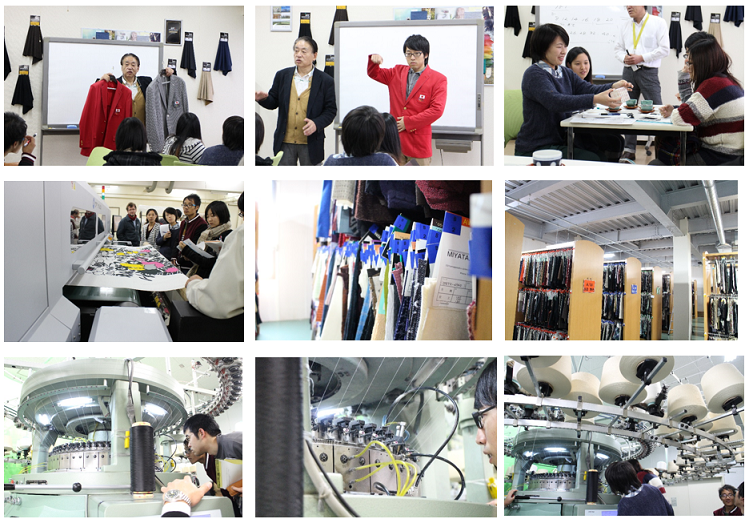Factory Tour No.3 (1/3)
As a part of the textile basics training, we had the third on-site visit for 2 days in December at the Bishu (Owari) production center, which is one of the two biggest production districts in the world (the other being Italy), in the field of lady's high quality woolen textiles. After an explanation about various kinds of fashion fabric manufacturing processes at the 4 leading companies, we had the tour through each factory. We felt, in common with them, that they had a strong posture on making their products at the highest possible quality. The four companies we visited have exemplified "manufacturing in Japan". We could have a glimpse of how textile products require many "hands, faith ", "skills", and "fusion of technology in the wide fields as science, technology, and kansei engineering".
1. Miyata Keori Kogyo Co., Ltd.
Miyata Keori Kogyo Co., Ltd. which we visited first, was founded in 1954. The company owns over 150 circle knitting machines which have a wide textile productive capacity from a low gauge to a high gauge, and produce mainly textiles for Lady's outer knitwear. They produce not only cotton hemp, and woolen natural material, but also composition textile with differentiated long textile materials such as the cupra triacetate. We realized that they utilize the regional characteristics of the Bishu production center to create textiles that could only be produced in Japan, while attaching importance to the comfortableness of the clothes.
We tried on the knit jacket, which was used as the official uniform of the Japanese Olympic team. We were surprised how comfortable it was, and it hardly became wrinkled. It was easy to pack compactly. Then we picked up samples and recognized the difference in texture between single-knit and double-knit. Afterwards, we observed the production factory. We saw the operation of the latest inkjet printer, which allows for point of design to deal with rapidly changing consumer demand. In addition, they could print knit textile with patterns using this printer, and the dye that was used adapted to "Oeko-Tex standard 100" from a point of view of the environmental protection. The Ichinomiya factory warehouse holds approximately 45,000 textile samples, such as textiles for summer and winter from 1985. These have been kept so customers could re-order ones that they wanted according to the colors and feel of the textures. This is an important resource for the fiber industry, which other companies could also benefit from.
Observing the operation of the circle knitting machine, we could see where and how threads passed to comprise the mesh of knitted textiles and needles drove. We also observed various knitting machines such as single knit circular knitting machines, double knit circular knitting machine, and jacquard looms. We learned that the quality of thread using mainly natural materials in the production of textiles varies greatly. The quality of products often depends on the ability of the person in charge of the machinery, so it is very important to educate employees daily on the maintenance of the machines. We could deeply understand that clear faith and focus "to be particular about quality and to make fine products" that has sustained Miyata Keori Kogyo Co., Ltd. in a price sensitive market through the development of industrial technology and quality.
